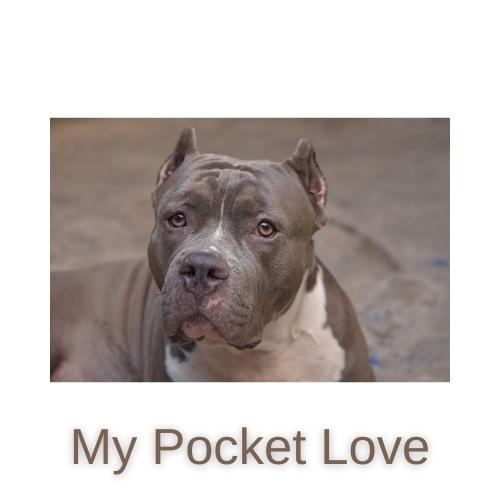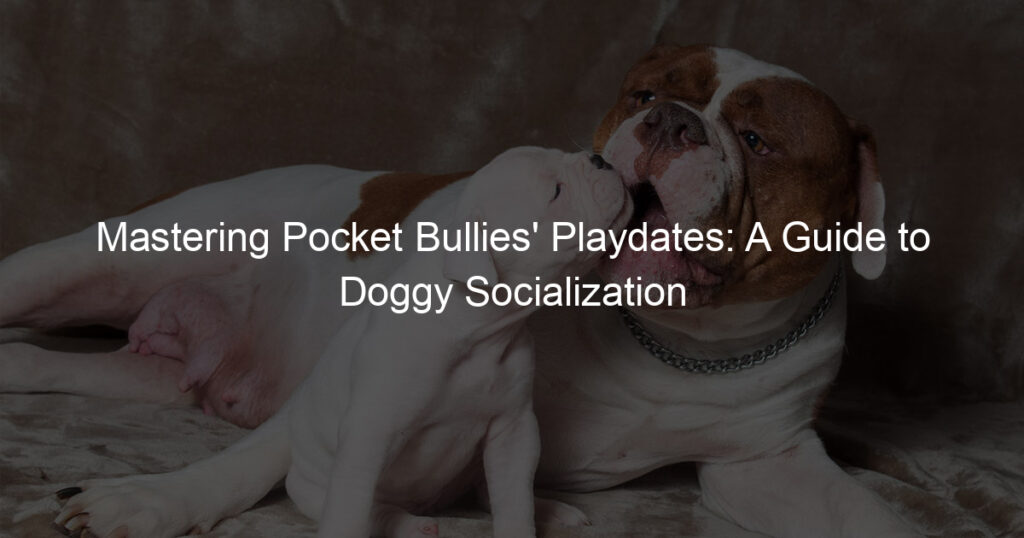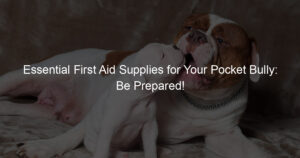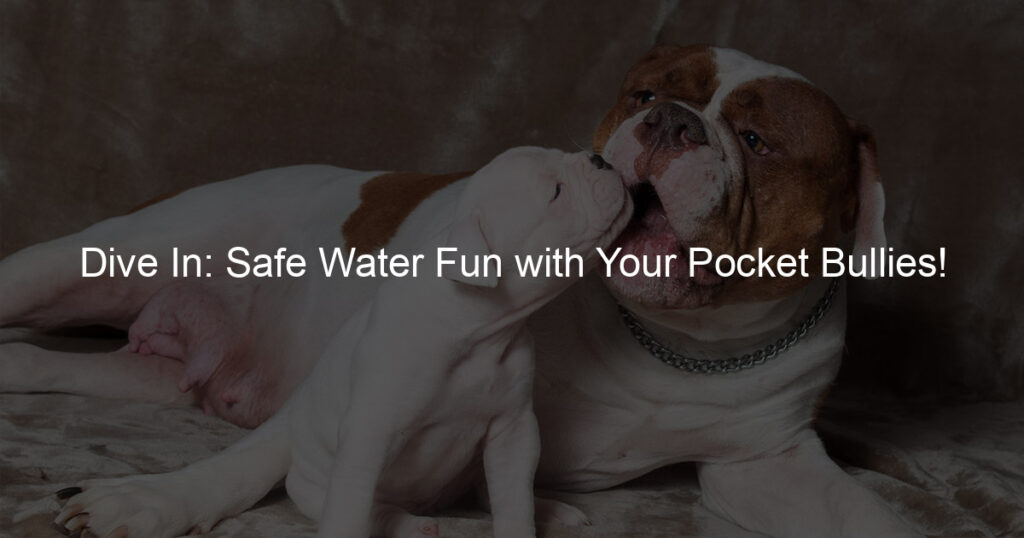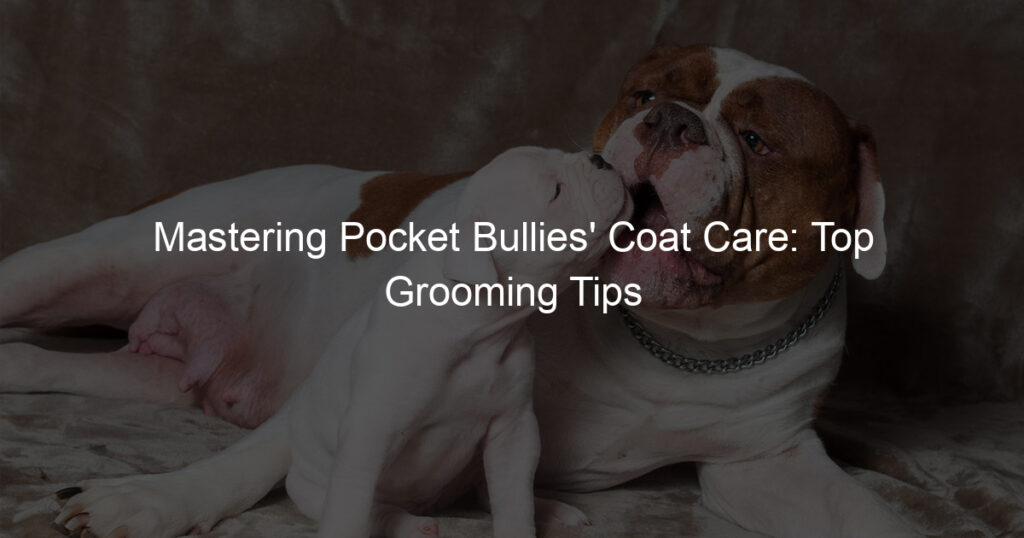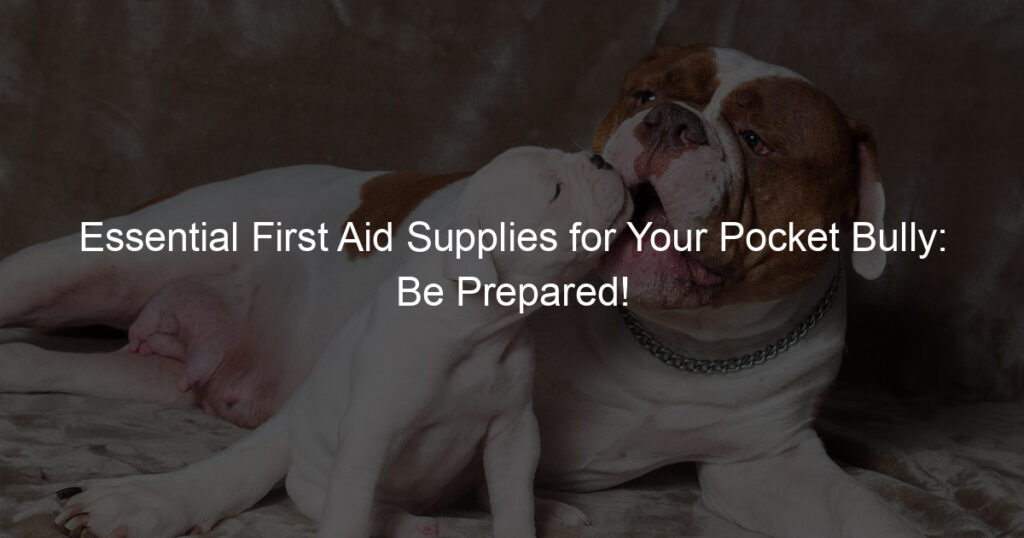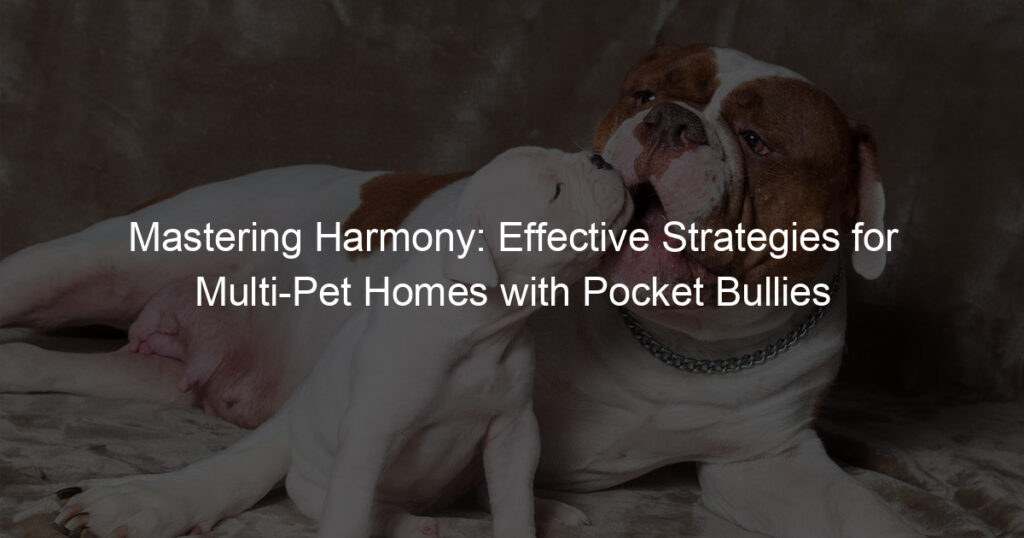
Introduction to Pocket Bullies Socialization
Welcome to our comprehensive guide on Pocket Bullies socialization. This section will help you understand the importance of socializing your Pocket Bullies, clear up common misconceptions about their behavior, and highlight the benefits of proper socialization.
- Understanding the importance of socializing Pocket Bullies
- Common misconceptions about Pocket Bullies behavior
- Benefits of proper socialization of Pocket Bullies
Socialization is a crucial part of a Pocket Bullies’ upbringing. It involves exposing your dog to a variety of experiences, including different environments, people, and other animals. This process helps your Pocket Bullies develop confidence and reduces the likelihood of fearful or aggressive behavior. According to the American Kennel Club, dogs that are well-socialized are generally happier and more relaxed in different situations.
There are several misconceptions about Pocket Bullies, with one of the most common being that they are naturally aggressive. This is not true. Like any other breed, Pocket Bullies’ behavior is largely influenced by their upbringing and socialization. Another misconception is that older Pocket Bullies cannot be socialized. While it’s true that socialization is easiest when the dog is a puppy, older dogs can also learn to adapt to new experiences and environments.
Proper socialization offers numerous benefits for Pocket Bullies. It helps them become well-adjusted pets that can interact safely with other animals and people. A well-socialized Pocket Bully is less likely to exhibit problem behaviors such as excessive barking, chewing, or aggression. Furthermore, socialization can also improve your dog’s mental health, reducing anxiety and stress levels.
In the following sections, we will delve deeper into the steps to socialize Pocket Bullies, training methods, and real-life case studies. Stay tuned to learn more about this important aspect of your Pocket Bullies’ life.
Steps to Socialize Pocket Bullies
One of the most important aspects of raising a happy and well-adjusted Pocket Bully is proper socialization. This process involves teaching your dog how to interact appropriately with other animals and people. Here are some steps to help you socialize your Pocket Bully effectively.
Step 1: Understanding Your Pocket Bullies’ Behavior
Before you can begin socializing your Pocket Bully, it’s crucial to understand their behavior. This will enable you to identify any signs of fear or aggression, and address them appropriately.
- Identifying signs of fear or aggression: Pocket Bullies, like all dogs, have specific ways of showing fear or aggression. These might include growling, barking, or showing their teeth. If you notice these signs, it’s important to address them right away. This might involve consulting with a professional dog trainer or behaviorist.
- Understanding the importance of early socialization: The earlier you start socializing your Pocket Bully, the better. Puppies are most receptive to new experiences between 3 and 12 weeks of age. During this time, they should be exposed to a variety of people, animals, environments, and experiences. This will help them grow into confident and well-adjusted adults.
Understanding your Pocket Bully’s behavior is the first step towards successful socialization. By identifying signs of fear or aggression and recognizing the importance of early socialization, you can help your dog become a well-rounded and sociable pet.
Step 2: Introducing Pocket Bullies to New Environments
One of the most important steps in socializing your Pocket Bullies is introducing them to new environments. This process should be gradual and carefully planned to ensure your dog’s comfort and safety. Here are some key steps to follow:
- Choosing the right environment for socialization
- Introducing new smells and sounds gradually
When introducing your Pocket Bullies to new environments, it’s crucial to choose the right setting. This should ideally be a calm and controlled environment where your dog can explore without feeling overwhelmed. Parks, quiet streets, or a friend’s house can be good options. Remember, the goal is to gradually expose your dog to different environments, not to shock them with too much novelty at once.
Just like humans, dogs experience the world through their senses. New smells and sounds can be exciting but also a bit scary for your Pocket Bullies. Introduce these new sensory experiences gradually. Start with short visits to new environments and gradually increase the duration. This will allow your dog to get used to the new smells and sounds without feeling overwhelmed.
Remember, patience is key when socializing your Pocket Bullies. It’s a process that takes time and should never be rushed. Always monitor your dog’s reactions and adjust your approach accordingly. With time and patience, your Pocket Bullies will become well-adjusted and confident in various environments.
| Key Points |
|---|
| Choose calm and controlled environments for initial socialization |
| Introduce new smells and sounds gradually |
| Monitor your dog’s reactions and adjust your approach accordingly |
| Patience is key in the socialization process |
Step 3: Pocket Bullies Interaction with Other Dogs
Now that we’ve covered understanding your Pocket Bullies’ behavior and introducing them to new environments, it’s time to discuss their interaction with other dogs. This step is crucial for their socialization process.
- Choosing the right playmates for your Pocket Bullies
- Monitoring the playdate to ensure positive interactions
Not all dogs are suitable playmates for your Pocket Bullies. It’s essential to choose dogs that are friendly and well-socialized. Dogs of a similar size and energy level often make the best playmates. Avoid aggressive or overly dominant dogs, as they can scare your Pocket Bullies or lead to negative interactions.
Once you’ve found the right playmates, it’s important to monitor their interactions closely. Look for signs of positive play, like wagging tails and relaxed body language. If you see signs of fear or aggression, it’s time to step in and separate the dogs. Remember, the goal is to make socialization a positive experience for your Pocket Bullies.
Let’s summarize this information in a table for easy reference:
| Steps for Successful Playdates | Details |
|---|---|
| Choosing the right playmates | Choose friendly, well-socialized dogs of a similar size and energy level. |
| Monitoring the playdate | Look for signs of positive play and step in if you see fear or aggression. |
By following these steps, you can help your Pocket Bullies have positive interactions with other dogs and become well-socialized pets.
Training Pocket Bullies for Socialization
Training your Pocket Bullies for socialization is a crucial step in ensuring they grow into well-behaved and friendly dogs. This process involves teaching them how to interact positively with other animals and humans. Let’s delve into some basic training techniques that can help in this process.
Basic Training Techniques
There are two fundamental training techniques that every Pocket Bullies owner should know. These techniques are not only easy to implement but also effective in teaching your dogs the basics of good behavior.
- Using positive reinforcement to encourage good behavior
- Teaching your Pocket Bullies to respond to basic commands
Positive reinforcement is a powerful training technique that involves rewarding your dog for displaying good behavior. This could be anything from giving them a treat, petting them, or showering them with praise. The idea is to make the dog associate good behavior with positive outcomes. For instance, if your Pocket Bullies sit when told to, give them a treat. They will soon learn that sitting when told to earns them a reward, encouraging them to repeat the behavior.
Teaching your Pocket Bullies to respond to basic commands is another essential training technique. Start with simple commands like ‘sit’, ‘stay’, ‘come’, and ‘no’. Be consistent and patient with your training. Remember, it’s important to reward your dog every time they successfully follow a command. This will motivate them to listen and respond to your commands more frequently.
In conclusion, training your Pocket Bullies for socialization is a process that requires patience and consistency. By using positive reinforcement and teaching them to respond to basic commands, you can lay a solid foundation for their socialization training. Remember, the goal is to help your Pocket Bullies become well-behaved and friendly dogs that can interact positively with other animals and humans.
Advanced Training Techniques
As your Pocket Bullies grow and their understanding develops, you can begin to introduce more complex commands. This section will provide you with a guide on how to teach your Pocket Bullies to respond to complex commands and the benefits of using professional trainers for advanced training.
- Teaching your Pocket Bullies to respond to complex commands
Complex commands go beyond the basic ‘sit’, ‘stay’, and ‘come’. They involve multiple steps and require your Pocket Bullies to think and react. Examples of complex commands include ‘fetch the ball’, ‘go to your bed’, or ‘find your toy’. Teaching these commands not only stimulates your dog’s mind but also strengthens your bond with them.
Start by choosing a command and breaking it down into simple steps. For example, for ‘fetch the ball’, you could start by teaching your dog to recognize the ball, then to pick it up, and finally to bring it back to you. Use positive reinforcement, like treats or praise, to reward your dog when they successfully complete each step.
Remember, patience is key. It may take several weeks for your Pocket Bullies to fully understand and respond to a complex command. Don’t rush the process. Instead, celebrate each small success and keep the training sessions fun and positive.
- Using professional trainers for advanced training
While it’s possible to train your Pocket Bullies at home, professional trainers can provide a level of expertise and experience that’s hard to match. They understand dog behavior and can tailor training methods to suit your dog’s personality and learning style.
Professional trainers also have the skills to handle more challenging behaviors and can provide guidance on advanced training techniques. They can help your Pocket Bullies master complex commands more quickly and effectively.
Investing in professional training can be a great way to ensure your Pocket Bullies are well-socialized and obedient. It can also save you time and effort in the long run.
In conclusion, advanced training techniques can greatly benefit your Pocket Bullies. Whether you choose to teach complex commands at home or hire a professional trainer, remember that consistency, patience, and positive reinforcement are the keys to successful training.
Pocket Bullies Socialization Case Studies
Let’s delve into some real-life examples to better understand the process and importance of socializing Pocket Bullies. We will look at two case studies that highlight different aspects of socialization.
-
Case Study 1: Successful Socialization of an Adult Pocket Bullies
Meet Max, a 3-year-old Pocket Bullies. When Max’s owners adopted him, he was not well-socialized and had difficulty interacting with other dogs and people. His owners decided to take a structured approach to socialize him.
They started by introducing Max to a calm and friendly dog. Initially, Max was hesitant, but over time, he began to feel comfortable. They also took Max to different environments like parks, pet stores, and busy streets to expose him to various sights, sounds, and smells. After a few months of consistent socialization, Max became more confident and friendly.
This case study shows that even adult Pocket Bullies can be successfully socialized with patience and consistency.
-
Case Study 2: Overcoming Fear and Aggression in a Young Pocket Bullies
Next, we have Bella, a young Pocket Bullies who showed signs of fear and aggression. Bella would bark and growl at strangers and other dogs. Her owners realized that Bella’s behavior was due to fear and lack of socialization.
They sought help from a professional dog trainer who suggested a gradual approach to socialization. Bella was slowly introduced to new people and dogs in a controlled environment. Her owners also used positive reinforcement, rewarding Bella with treats and praise whenever she behaved calmly around others.
Over time, Bella’s fear and aggression reduced significantly. She became more comfortable around others and even started to enjoy meeting new dogs and people. This case study demonstrates that fear and aggression in Pocket Bullies can be managed with proper socialization and training.
In conclusion, these case studies highlight the importance of socialization for Pocket Bullies. Whether they are adults or young pups, with patience, consistency, and the right approach, they can become well-adjusted and friendly companions.
Conclusion: The Importance of Consistent Socialization
In wrapping up, we cannot overemphasize the importance of consistent socialization for Pocket Bullies. It’s not just about making your dog friendly; it’s about ensuring they grow up to be well-rounded, confident, and happy dogs. Let’s revisit some of the benefits of socializing Pocket Bullies and key takeaways for successful socialization.
- Revisiting the benefits of socializing Pocket Bullies
- Key takeaways for successful Pocket Bullies socialization
As we’ve discussed, socializing your Pocket Bullies has numerous benefits. It helps them to be more comfortable in various environments, reduces the likelihood of them developing fear or aggression, and promotes their overall well-being. It also makes them easier to manage and more enjoyable to be around, both for you and others.
Successful socialization is not a one-time event but a continuous process. It’s about exposing your Pocket Bullies to different people, environments, and experiences in a controlled and positive way. Remember, it’s crucial to start as early as possible, ideally during the puppy stage. However, it’s never too late to start. Be patient, consistent, and make every experience a positive one for your Pocket Bullies.
Consistent socialization is a commitment that requires time and effort. However, the rewards are worth it. Your Pocket Bullies will be happier, more confident, and better behaved. They’ll be a joy to be around and a source of pride for you as their owner. So, keep up the good work and continue to invest in your Pocket Bullies’ socialization. They’ll thank you for it in their own special way!
